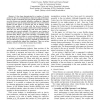Free Online Productivity Tools
i2Speak
i2Symbol
i2OCR
iTex2Img
iWeb2Print
iWeb2Shot
i2Type
iPdf2Split
iPdf2Merge
i2Bopomofo
i2Arabic
i2Style
i2Image
i2PDF
iLatex2Rtf
Sci2ools
96
Voted
ICRA
2005
IEEE
2005
IEEE
Adaptive Virtual Fixtures for Machine-Assisted Teleoperation Tasks
— It has been demonstrated in a number of robotic areas how the use of virtual fixtures improves task performance both in terms of execution time and overall precision, [1]. However, the fixtures are typically inflexible, resulting in a degraded performance in cases of unexpected obstacles or incorrect fixture models. In this paper, we propose the use of adaptive virtual fixtures that enable us to cope with the above problems. A teleoperative or human machine collaborative setting is assumed with the core idea of dividing the task, that the operator is executing, into several subtasks. The operator may remain in each of these subtasks as long as necessary and switch freely between them. Hence, rather than executing a predefined plan, the operator has the ability to avoid unforeseen obstacles and deviate from the model. In our system, the probability that the user is following a certain trajectory (subtask) is estimated and used to automatically adjusts the compliance. Thus, an ...
| Added | 25 Jun 2010 |
| Updated | 25 Jun 2010 |
| Type | Conference |
| Year | 2005 |
| Where | ICRA |
| Authors | Daniel Aarno, Staffan Ekvall, Danica Kragic |
Comments (0)

